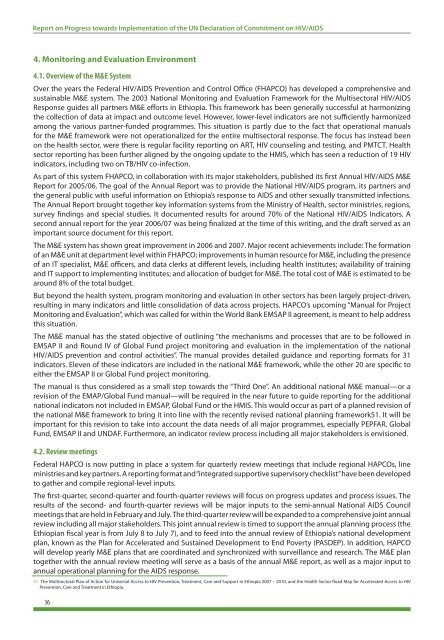Ethiopia - Country Progress Report - unaids
Ethiopia - Country Progress Report - unaids
Ethiopia - Country Progress Report - unaids
You also want an ePaper? Increase the reach of your titles
YUMPU automatically turns print PDFs into web optimized ePapers that Google loves.
<strong>Report</strong> on <strong>Progress</strong> towards Implementation of the UN Declaration of Commitment on HIV/AIDS<br />
4. Monitoring and Evaluation Environment<br />
4.1. Overview of the M&E System<br />
Over the years the Federal HIV/AIDS Prevention and Control Office (FHAPCO) has developed a comprehensive and<br />
sustainable M&E system. The 2003 National Monitoring and Evaluation Framework for the Multisectoral HIV/AIDS<br />
Response guides all partners M&E efforts in <strong>Ethiopia</strong>. This framework has been generally successful at harmonizing<br />
the collection of data at impact and outcome level. However, lower-level indicators are not sufficiently harmonized<br />
among the various partner-funded programmes. This situation is partly due to the fact that operational manuals<br />
for the M&E framework were not operationalized for the entire multisectoral response. The focus has instead been<br />
on the health sector, were there is regular facility reporting on ART, HIV counseling and testing, and PMTCT. Health<br />
sector reporting has been further aligned by the ongoing update to the HMIS, which has seen a reduction of 19 HIV<br />
indicators, including two on TB/HIV co-infection.<br />
As part of this system FHAPCO, in collaboration with its major stakeholders, published its first Annual HIV/AIDS M&E<br />
<strong>Report</strong> for 2005/06. The goal of the Annual <strong>Report</strong> was to provide the National HIV/AIDS program, its partners and<br />
the general public with useful information on <strong>Ethiopia</strong>’s response to AIDS and other sexually transmitted infections.<br />
The Annual <strong>Report</strong> brought together key information systems from the Ministry of Health, sector ministries, regions,<br />
survey findings and special studies. It documented results for around 70% of the National HIV/AIDS Indicators. A<br />
second annual report for the year 2006/07 was being finalized at the time of this writing, and the draft served as an<br />
important source document for this report.<br />
The M&E system has shown great improvement in 2006 and 2007. Major recent achievements include: The formation<br />
of an M&E unit at department level within FHAPCO; improvements in human resource for M&E, including the presence<br />
of an IT specialist, M&E officers, and data clerks at different levels, including health institutes; availability of training<br />
and IT support to implementing institutes; and allocation of budget for M&E. The total cost of M&E is estimated to be<br />
around 8% of the total budget.<br />
But beyond the health system, program monitoring and evaluation in other sectors has been largely project-driven,<br />
resulting in many indicators and little consolidation of data across projects. HAPCO’s upcoming “Manual for Project<br />
Monitoring and Evaluation”, which was called for within the World Bank EMSAP II agreement, is meant to help address<br />
this situation.<br />
The M&E manual has the stated objective of outlining “the mechanisms and processes that are to be followed in<br />
EMSAP II and Round IV of Global Fund project monitoring and evaluation in the implementation of the national<br />
HIV/AIDS prevention and control activities”. The manual provides detailed guidance and reporting formats for 31<br />
indicators. Eleven of these indicators are included in the national M&E framework, while the other 20 are specific to<br />
either the EMSAP II or Global Fund project monitoring.<br />
The manual is thus considered as a small step towards the “Third One”. An additional national M&E manual—or a<br />
revision of the EMAP/Global Fund manual—will be required in the near future to guide reporting for the additional<br />
national indicators not included in EMSAP, Global Fund or the HMIS. This would occur as part of a planned revision of<br />
the national M&E framework to bring it into line with the recently revised national planning framework51. It will be<br />
important for this revision to take into account the data needs of all major programmes, especially PEPFAR, Global<br />
Fund, EMSAP II and UNDAF. Furthermore, an indicator review process including all major stakeholders is envisioned.<br />
4.2. Review meetings<br />
Federal HAPCO is now putting in place a system for quarterly review meetings that include regional HAPCOs, line<br />
ministries and key partners. A reporting format and “integrated supportive supervisory checklist” have been developed<br />
to gather and compile regional-level inputs.<br />
The first-quarter, second-quarter and fourth-quarter reviews will focus on progress updates and process issues. The<br />
results of the second- and fourth-quarter reviews will be major inputs to the semi-annual National AIDS Council<br />
meetings that are held in February and July. The third-quarter review will be expanded to a comprehensive joint annual<br />
review including all major stakeholders. This joint annual review is timed to support the annual planning process (the<br />
<strong>Ethiopia</strong>n fiscal year is from July 8 to July 7), and to feed into the annual review of <strong>Ethiopia</strong>’s national development<br />
plan, known as the Plan for Accelerated and Sustained Development to End Poverty (PASDEP). In addition, HAPCO<br />
will develop yearly M&E plans that are coordinated and synchronized with surveillance and research. The M&E plan<br />
together with the annual review meeting will serve as a basis of the annual M&E report, as well as a major input to<br />
annual operational planning for the AIDS response.<br />
51 The Multisectoral Plan of Action for Universal Access to HIV Prevention, Treatment, Care and Support in <strong>Ethiopia</strong> 2007 – 2010, and the Health Sector Road Map for Accelerated Access to HIV<br />
Prevention, Care and Treatment in <strong>Ethiopia</strong>.<br />
36

















